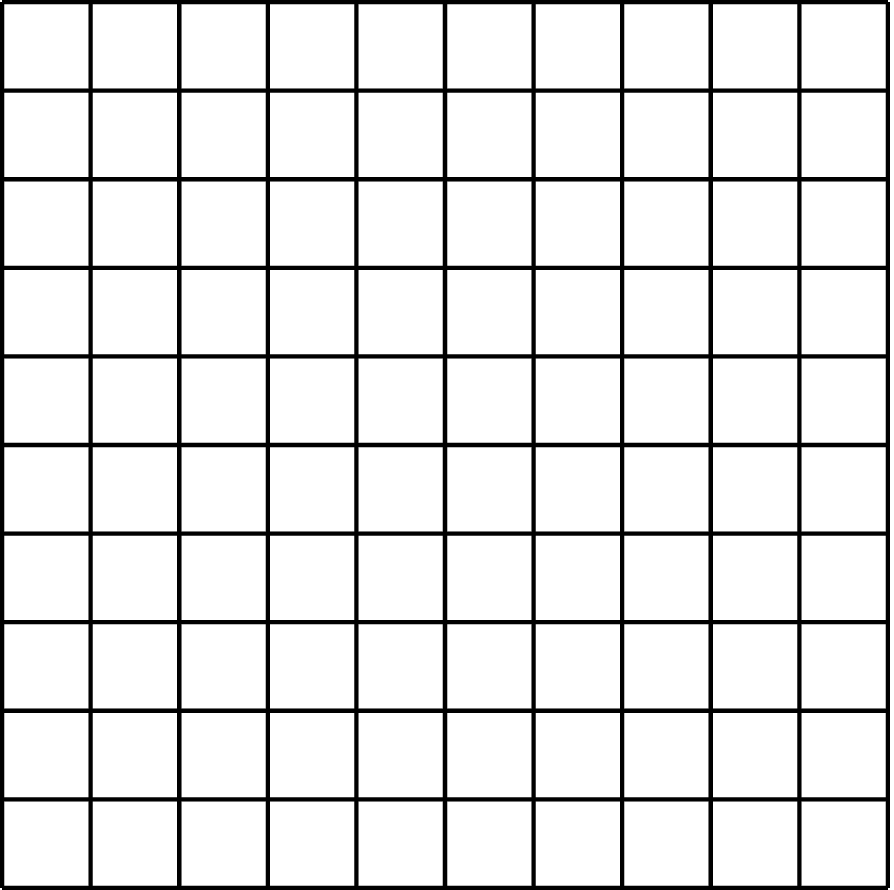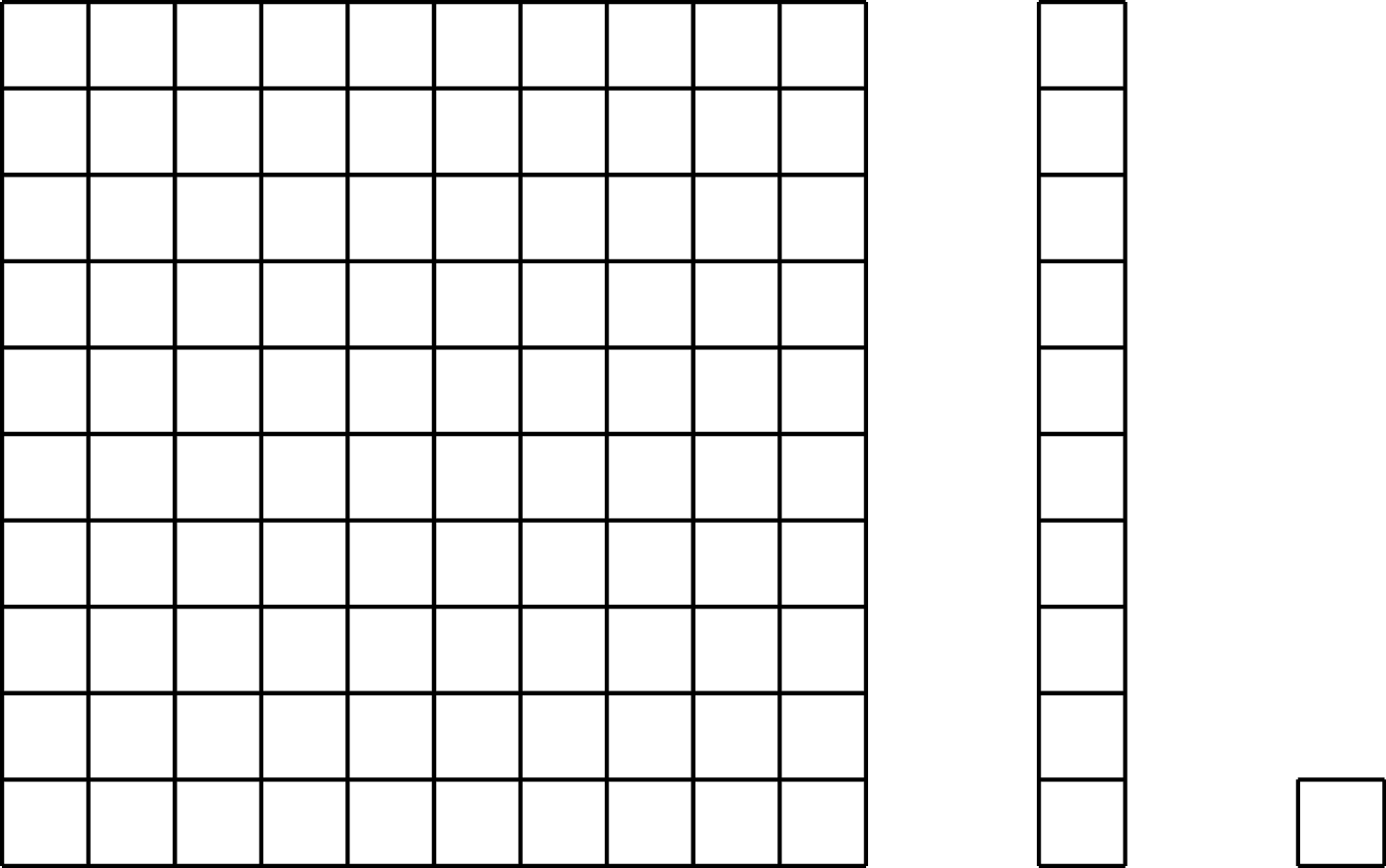Lesson 2
Multiplying Powers of Ten
2.1: 100, 1, or $\frac{1}{100}$? (5 minutes)
Warm-up
This warm-up gives students a chance to think about different numbers that a diagram might represent. In later activities, students thinking about diagrams that represent different powers of 10.
Launch
Give students 1 minute of quiet think time followed by 2 minutes of partner discussion.
Student Facing

Clare said she sees 100.
Tyler says he sees 1.
Mai says she sees \(\frac{1}{100}\).
Who do you agree with?
Student Response
For access, consult one of our IM Certified Partners.
Activity Synthesis
Poll the class to see who agrees with each person in turn. Then ask someone to explain in each case.
2.2: Picture a Power of 10 (15 minutes)
Activity
The purpose of this activity is for students to develop a sense of visual scale between powers of 10. Students should understand that multiplying by 10 corresponds to increasing the exponent by 1. Even though the notation for \(10^{100}\) does not appear to be much different than \(10^{98}\), it is 100 times larger. Small changes in the exponent can result in large changes in the value of the expression.
Launch
Arrange students in groups of 2. Give students 5 minutes of quiet work time followed by 5 minutes to share their responses with their partner and a whole-class discussion.
Supports accessibility for: Conceptual processing; Visual-spatial processing
Design Principle(s): Support sense-making
Student Facing
In the diagram, the medium rectangle is made up of 10 small squares. The large square is made up of 10 medium rectangles.

- How could you represent the large square as a power of 10?
- If each small square represents \(10^2\), then what does the medium rectangle represent? The large square?
- If the medium rectangle represents \(10^5\), then what does the large square represent? The small square?
- If the large square represents \(10^{100}\), then what does the medium rectangle represent? The small square?
Student Response
For access, consult one of our IM Certified Partners.
Anticipated Misconceptions
Students may multiply the exponent by 10, for example \(10^2\), \(10^{20}\), \(10^{200}\). Ask these students to write out what \(10^{20}\) would mean and whether that matches their intention.
Activity Synthesis
The key takeaway is that increasing the exponent of a power of 10 by 1 corresponds to multiplying or dividing by 10, and decreasing the exponent by 1 corresponds to dividing by 10.
Ask students to share their responses for the last several questions. Record and display their responses for all to see. If possible, reference the image to highlight the magnitude of change when the power of 10 increases or decreases by 1 or 2. If a student gives an answer such as, “the area of the medium rectangle is \(10^2 + 10^2 +.... + 10^2\), ask for volunteers to help write the expression using a single power of 10.
If projection is available, consider sharing this applet, which illustrates animals measured in units that vary by powers of ten. https://ggbm.at/NhpASDzz
2.3: Multiplying Powers of Ten (15 minutes)
Activity
The goal of this activity is to help students flexibly transition between different notations for powers of 10 and introduce the property of multiplication of values with the same base. Students observe that \(10^n \boldcdot 10^m = 10^{n+m}\) for values of \(n\) and \(m\) that are positive integers. The second question hints at the reasoning that will extend exponent rules to include zero exponents, but students will investigate that more deeply in a later lesson.
Notice students who need help writing the general rule in in terms of \(n\) and \(m\). You might ask, “What patterns did you notice with the exponents in the table? So if the exponents are \(n\) and \(m\), how do you write what you did with the exponents?”
Launch
Give students 1 minute of quiet think time to complete the first unfinished row in the table before asking 1–2 students to share and explain their answers. When it is clear that students know how to complete the table, explain to them that they can skip one entry in the table, but they have to be able to explain why they skipped it. Give students 7–8 minutes to work before a brief whole-class discussion.
Student Facing
-
- Complete the table to explore patterns in the exponents when multiplying powers of 10. You may skip a single box in the table, but if you do, be prepared to explain why you skipped it.
expression expanded single power of 10 \(10^2 \boldcdot 10^3\) \((10 \boldcdot 10)(10\boldcdot 10 \boldcdot 10)\) \(10^5\) \(10^4 \boldcdot 10^3\) \(10^4 \boldcdot 10^4\) \((10 \boldcdot 10 \boldcdot 10)(10 \boldcdot 10 \boldcdot 10 \boldcdot 10 \boldcdot 10)\) \(10^{18} \boldcdot 10^{23}\) - If you chose to skip one entry in the table, which entry did you skip? Why?
- Complete the table to explore patterns in the exponents when multiplying powers of 10. You may skip a single box in the table, but if you do, be prepared to explain why you skipped it.
-
- Use the patterns you found in the table to rewrite \(10^n \boldcdot 10^m\) as an equivalent expression with a single exponent, like \(10^{\boxed{\phantom{3}}}\).
- Use your rule to write \(10^4 \boldcdot 10^0\) with a single exponent. What does this tell you about the value of \(10^0\)?
- The state of Georgia has roughly \(10^7\) human residents. Each human has roughly \(10^{13}\) bacteria cells in his or her digestive tract. How many bacteria cells are there in the digestive tracts of all the humans in Georgia?
Student Response
For access, consult one of our IM Certified Partners.
Student Facing
Are you ready for more?
There are four ways to make \(10^4\) by multiplying powers of 10 with smaller, positive exponents.
\(\displaystyle 10^1 \boldcdot 10^1 \boldcdot 10^1 \boldcdot 10^1\)
\(\displaystyle 10^1 \boldcdot 10^1 \boldcdot 10^2\)
\(\displaystyle 10^1 \boldcdot 10^3\)
\(\displaystyle 10^2 \boldcdot 10^2\)
(This list is complete if you don't pay attention to the order you write them in. For example, we are only counting \(10^1 \boldcdot 10^3\) and \(10^3 \boldcdot 10^1\) once.)
- How many ways are there to make \(10^6\) by multiplying smaller powers of 10 together?
- How about \(10^7\)? \(10^8\)?
Student Response
For access, consult one of our IM Certified Partners.
Activity Synthesis
Create and post visual displays showing the exponent rules for reference throughout the unit, with one visual display for each rule. The visual display could include an example to illustrate how the rule works, along with visual aids and use of color. Here is a sample visual display:

Explain the visual display to students and display it for all to see throughout the unit.
Design Principle(s): Maximize meta-awareness.
Lesson Synthesis
Lesson Synthesis
The purpose of the discussion is to check whether students understand why \(10^n \boldcdot 10^m = 10^{n+m}\). Consider recording student responses and displaying them for all to see.
Here are some questions for discussion:
- “How could you write \(10^{15} \boldcdot 10^{5}\) using a single exponent without expanding all of the factors?” (The first part is 15 factors that are 10 and the second is 5 factors that are 10. This makes a total of 20 factors that are 10.)
- “In general, what is a rule for multiplying two powers of 10 together into a single power of 10?” (The exponents of the two powers of 10 are added together.)
2.4: Cool-down - That's a Lot of Dough, Though! (5 minutes)
Cool-Down
For access, consult one of our IM Certified Partners.
Student Lesson Summary
Student Facing
In this lesson, we developed a rule for multiplying powers of 10: multiplying powers of 10 corresponds to adding the exponents together. To see this, multiply \(10^5\) and \(10^2\). We know that \(10^5\) has five factors that are 10 and \(10^2\) has two factors that are 10. That means that \(10^5 \boldcdot 10^2\) has 7 factors that are 10. \(\displaystyle 10^5 \boldcdot 10^2 =(10 \boldcdot 10 \boldcdot 10 \boldcdot 10 \boldcdot 10) \boldcdot (10 \boldcdot 10)= 10^7.\)This will work for other powers of 10 too. So \(10^{14} \boldcdot 10^{47} = 10^{61}\).
This rule makes it easier to understand and work with expressions that have exponents.